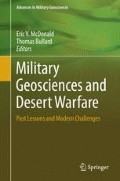Abstract
The history of the US Army Yuma Proving Ground (YPG) as the location for the scientific investigation of the natural environmental effects of desert climactic conditions on men and material of the United States Armed Forces, begins with the national response to our entry into World War II. As the Nation awoke to the terrible news of the Japanese attack on Pearl Harbor, we also awoke to the fact that as a Nation we were totally unprepared for war. The Desert southwest of North America was seen as an ideal location to take care of many of these issues of military preparedness that now faced the Nation. General Patton’s Desert Training Center (DTC) was established to quickly get our forces ready for War in North Africa. The DTC would evolve to become so much more. War-time requirements undertaken in the Desert Southwest came with an extreme sense of urgency. In an effort to compress development time for the new and improved materials of war, Research, Development, Test & Evaluation (R, D,T&E) was conducted in the natural environment in order to more quickly derive results. The U.S. Army Quartermaster Corps, along with the Ordnance Corps would see the harsh environment and topography of Camp Seeley CA as offering ideal environmental conditions in which to test Army vehicles and their sub-systems. The U.S. Army Corps of Engineers would establish the Yuma Test Branch at the Imperial Dam, the ideal location to test tactical bridging equipment. In many cases, the Yuma Proving Ground occupies the same geography as these precursor facilities. In other cases it is the mission and heritage of those war-time entities that have continued to evolve at the Proving Ground. This paper covers this initial historic period, a period that covers from 1942 until 1950.
Access this chapter
Tax calculation will be finalised at checkout
Purchases are for personal use only
References
Barnes GW (1947) Weapons of World War II. D. Van Nostrand Company Inc., New York
Bischoff MC (2000) The desert training center/California—Arizona maneuver area, 1942–1944, historical and archeological contexts. Statistical Research Inc., Tucson
Bischoff MC (2002) The desert training center/California—Arizona maneuver area, 1942–1944. Volume 1: Historical and archaeological contexts for the California desert, Technical Series 75, Statistical Research Inc., Tucson, Arizona
Coll BD, Keith JE, et al (1958) The corps of engineers: troops and equipment. Washington DC, Office of the Chief of Military History United States Army
Doughty RA (1979) The evolution of US army tactical doctrine, 1946–1976. Fort Leavenworth KS, Combat Studies Institute, Command and General Staff College
Engler JE (1945) The ordnance desert proving ground—its history and what it does. Camp Seeley CA: Un-published manuscript obtained by John Holman, soldier assigned to the ODPG
Garret J (1999) Task force Smith: the lessons never learned: school of advanced military studies, United States Army Command and General Staff College, Fort Leavenworth, KS
Heidorn KC (2002) Paul Siple: man of cold and wind. The Weather Doctor’s website. http://www.islandnet.com/~see/weather/history/siple.htm. Accessed March 2010
Howard GW (1976) Bridges in the desert: early days of the Yuma proving ground. Tucson AZ J Arizona Hist 17:431–450
Meller SL (1946) The desert training center and C-AMA: Study No. 15, Washington DC, Historical Section—The Army Ground Forces, Office of the Chief Military History, U.S. Army, Washington D.C.
Ordnance Test Activity (1952) Report of test operations at Yuma Test Station. Aberdeen, MD
Swisher B (2006) Oral history and conversations with major (USA, RET) bill swisher, first operations officer (S-3) of the Yuma test station. Interviews conducted between February and July of 2006 by William Heidner, Museum Curator, Heritage Center of YPG, Yuma, AZ
W.E.B.S. (1984) XXth corps: World War II Veterans yearbook prepared and written by XX Corps Personnel, Halstead Kansas, 1984 W.E.B.S. Inc.
Author information
Authors and Affiliations
Corresponding author
Editor information
Editors and Affiliations
Rights and permissions
Copyright information
© 2016 Springer Science+Business Media New York
About this paper
Cite this paper
Heidner, W. (2016). Preparing for War in the Desert Southwest; From the California—Arizona Maneuver Area to the Yuma Test Branch (and Beyond). In: McDonald, E., Bullard, T. (eds) Military Geosciences and Desert Warfare. Advances in Military Geosciences. Springer, New York, NY. https://doi.org/10.1007/978-1-4939-3429-4_3
Download citation
DOI: https://doi.org/10.1007/978-1-4939-3429-4_3
Published:
Publisher Name: Springer, New York, NY
Print ISBN: 978-1-4939-3427-0
Online ISBN: 978-1-4939-3429-4
eBook Packages: Earth and Environmental ScienceEarth and Environmental Science (R0)

